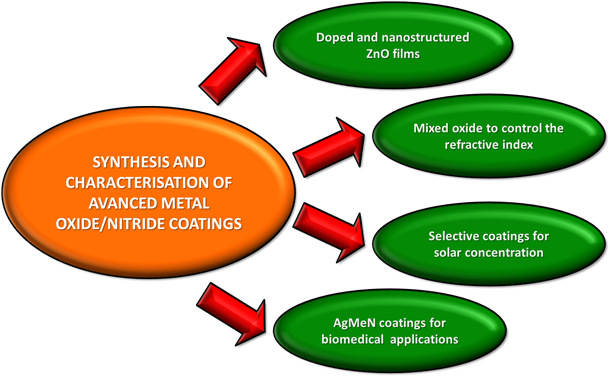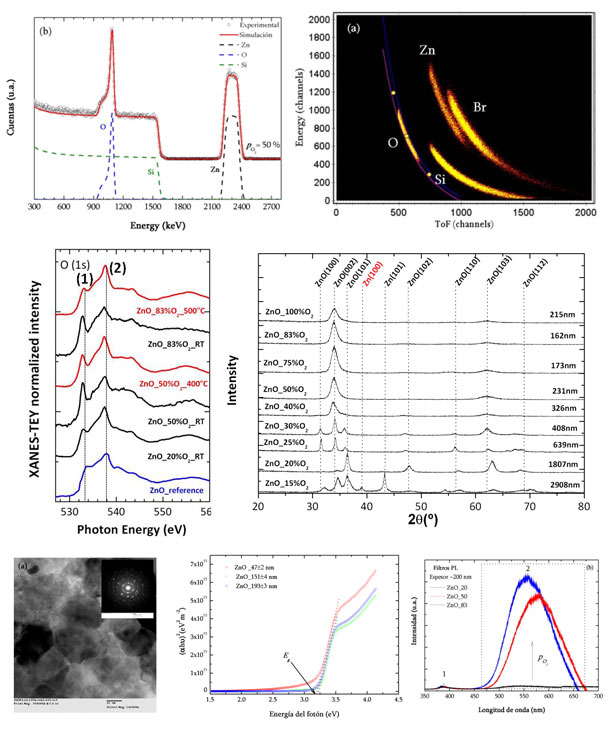Topics: PVD COATINGS
 |
- Doped and nanostructured ZnO films
- Synthesis and characterisation of ZnO films by DC sputtering at room temperature
- Incorporation of Ti in ZnO ultrathin films(< 30nm)
- ZnO deposition on nanostructured Al2O3 membranes
- Growth of ordered ZnO nanostructures by oblique angle deposition (OAD)
- Mixed oxides to control the refractive index
- Cr-Al and Cr-Si Mixed Oxides produced by magnetron sputtering
- Cr-Si Mixed Oxides Produced by Reactive Ion Beam Mixing
- Selective coatings for solar concentration applications
- Development of novel oxides and nitride based cermets for high temperature CSP coatings
- AgMeN coatings for biomedical applications
- Ag surface segretaion on Ag-TiCN coatings
- Controlled release of Ag+ in AgZrCN coatings
- Doped and nanostructured ZnO films:
- Synthesis and characterisation of ZnO films by DC sputtering at room temperatureSystematic study of chemical, structural and optical properties
- Characterisation by perfilometry, RBS, ERDA-TOF, GIXRD, IR, SEM, ellipsometry, XANES, TEM
- Stoichiometry control of ZnO films with % O2 in the gas flux
- Dependence in the preferential crystalline orientation with %O2 and thickness
- “Post-annealing” treatment to correlate the presence of oxygen with structural defects in the ZnO films
- Excellent optical (n y Eg) and structural (wurzite) properties
- Synthesis and characterisation of ZnO films by DC sputtering at room temperatureSystematic study of chemical, structural and optical properties
 |
- Related papers:
-
M. Yuste, R. Escobar Galindo, I. Caretti, R. Torres and O.Sánchez. Influence of the oxygen partial pressure and post-deposition annealing on the structure and optical properties of ZnO films grown by DC magnetron sputtering at room temperature. J. Phys. D: Appl. Phys. 45 (2012) 025303.
-
M. Jullien, D. Horwat, F. Manzeh, R. Escobar Galindo, Ph. Bauer, J.F. Pierson, J.L. Endrino. Influence of the nanoscale structural features on the properties and electronic structure of Al-doped ZnO thin films: an X-ray absorption study. Solar Energy Materials & Solar Cells 95 (2011) 2341–2346
-
- Incorporation of Ti in ZnO ultrathin films(< 30nm)
- Ti content (0-30 at.%) controled by tuning power on Ti, Zn cathodes
- Characterisation by RBS, XANES, XPS, TEM, 4-probe
- Structural and coordination changes from wurtzite (w-Zn(Ti)O) to ilmenite (h-ZnTiO3) structure
- Lowest resistivity of 10-2 Ω cm for TZO with 0.5 at% Ti
- Related papers:
-
I. Caretti, M. Yuste, R. Torres, O.Sánchez, I. Jimenez and R. Escobar Galindo. Coordination chemistry of titanium and zinc in Ti(1-x)Zn2xO2 (0 <= x <= 1) ultrathin films grown by DC reactive magnetron sputtering RSC Adv., 2012, 2 (7), 2696 – 2699
-
- ZnO deposition on nanostructured Al2O3 membranes
- Control on the pore diameter (10-100 nm)
- Negative replica of the membrane by ZnO sputtering deposition
- Ultrathin ZnO (30 nm) on 15 nm pore membrane
- Growth of ordered ZnO nanostructures by oblique angle deposition (OAD)
- Control on the stoichiometry and crystal orientation of OAD ZnO films by tuning pO2 and distance target-substrate
- ZnO refractive index modulation with angle of deposition due to density changes
- Related papers:
-
D. Toledano, R. Escobar Galindo, M. Yuste, J. M. Albella and O. Sánchez. Compositional and structural properties of nanostructured ZnO thin films grown by oblique angle reactive sputtering deposition: Effect on the refractive index. J. Phys. D: Appl. Phys. 46 (2012) 045306.
-

